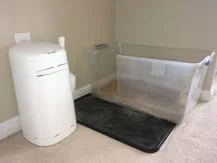New Cat? Have a read of the OVMA Cat Owner's Handbook
Declawing (more formally known as partial digit amputation)
- Paw Project (North American movement to ban declawing)
- SaveTheCouches.com (tips for how to live with a clawed cat)
- Declawing.com (what your cat would like you to know about this procedure)
- SoftPaws (pain-free alternative to declawing)
March 16, 2017: The Canadian Veterinary Medical Association opposes declawing
April 26, 2017: The Ontario Veterinary Medical Association opposes declawing
May 23, 2017: JFMS peer-reviewed research article linking declawing to chronic pain & behavioural problems comes out
March 15, 2018: Nova Scotia bans declawing
May 8, 2018: British Columbia bans declawing
November 7, 2018: PEI bans declawing
January 1, 2019: Newfoundland & Labrador ban declawing
May 30, 2019: Manitoba bans declawing
July 1, 2019: Alberta bans declawing & New Brunswick bans declawing
???: Ontario bans declawing... still just a dream but hopefully reality soon. December 8, 2020: MPP Marit Stiles introduces bill to ban declawing in Ontario.
Here is a 3 minute no-frills scientific explanation by Robin Downing DVM, MS, DAAPM, DACVSMR, CVPP, CCRP of why we do not declaw:
Feline Pain Scale
A helpful tool for assessing acute pain in cats
https://www.felinegrimacescale...
Nail Trimming
In our on-going effort to end declawing in Ontario, at Park Animal Hospital we offer FREE NAIL TRIMS TO EVERY CAT - whether a patient of ours or not. Should you wish to do it at home, here is a narrated 5 part video series with clear, easy to understand step-by-step instructions:
Scratching Post Tips
3 key points:
- Cats enjoy scratching, doing it is a sign of good health.
- Scratching posts need to be sturdy so that they don't move when your cat attempts to use them.
- Scratching posts need to be in a good location, en route as your cat travels from sleeping areas or litter boxes or feeding stations.
Scratch Lounge is a unique scratching post solution.
Transporting Your Cat to the Clinic
3 key points:
- Leave the carrier out so it becomes a part of your cat's environment, ideally even a place where your cat enjoys taking a nap.
- When traveling, cover the carrier with a towel to reduce the number of potentially scary external stimuli your cat is exposed to while driving and after you arrive at the clinic.
- In the car, place the carrier in the foot well behind the front seat for maximum safety.
NOTE: If needed, we can provide you with a very safe sedative for you to give your cat orally before loading them in the carrier to make the whole process easier on both of you.
Tips for Litterbox & Food/Water Bowl Placement
3 key points:
- The minimum number of ideal litter boxes is 1 per cat + 1, and they should not all be placed side-by-side but rather in different locations throughout your home.
- Litter boxes should be scooped at least once daily, no one likes a dirty toilet!
- Food and water bowls should not be placed next to each other, nor should they be placed next to the litter box.
The ideal litter box:
- has a shallow entry to allow arthritic cats easy access, a boot tray at the entry makes litter tracked on paws easy to clean up
- has tall sides to keep the litter in, translucency allows the cat in the box to be on the lookout for anyone who might be "stalking" him/her
- has a total length of 3 times the size of the body of the cats, allowing for comfortable maneuvering and digging
- has no hood
- has unscented, clumping litter
- is accessible without the use of stairs
- is not next to the feeding area
- is not next to objects which might suddenly make a loud noise unpredictably, such as a washer or furnace
Here is one of Dr Fenger's own homemade versions using a storage container. The white canister is a "LitterLocker" where scooped litter is stored keeping odours to a minimum.



How to Give Your Cat a Pill
3 key points:
- Have someone put their hands on the cat's back end, so the cat doesn't back out of reach - a corner of some kind or being wrapped in a towel also works well.
- Watch for the cat to lick their nose as a clue that they have swallowed - try to keep their mouth closed until this happens.
- Never "dry-pill", always flush the pill down the throat with a syringe of water or a couple of treats or some food (ideally moist), otherwise it can irritate the esophagus and be very uncomfortable for the cat. The food options are ideal because they double as a reward for for your cat letting you pill them.
Narrated, 10 part step-by-step instructional video series:
How to Give Your Cat Liquid Medication
Narrated, 3 part step-by-step instructional video series:
Recommended Products
- Habitat Haven (the safe way to let your cat enjoy the outdoors)
- Calm Carrier (the carrier your cat dreams of traveling in!)
Grooming
- Cleopawtra (in-home grooming)
Local Feline Rescue Groups
Purebred Cat Info
Miscellaneous Cat Sites We Love
- My Cat from Hell(TV show featuring Jackson Galaxy providing solutions to behavioural problems of cats, you can also read his tips here: Cat Daddy Tips)
- Feline Environmental Needs (an article from the Journal of Feline Medicine and Surgery with an overview of cat needs)
- Indoor Pet Initiative (information for handling indoor cat issues)
- CatInfo.org (benefits of canned food and how to convince your cat to eat it)
- PainFreeCats.org(how to assess the level of pain your cat may have)
- International Cat Care (information on cat diseases can be found here)
- The CATalyst Council (information on improving the health and welfare of your companion cat)
- Winn Feline Foundation (feline exclusive research)
- Partners in Animal Health (useful info from the cat lovers at Cornell University)
- Cornell Feline Health Center(info on diseases & feeding)
- The Cat Community (resource for all aspects of keeping your cat healthy)






